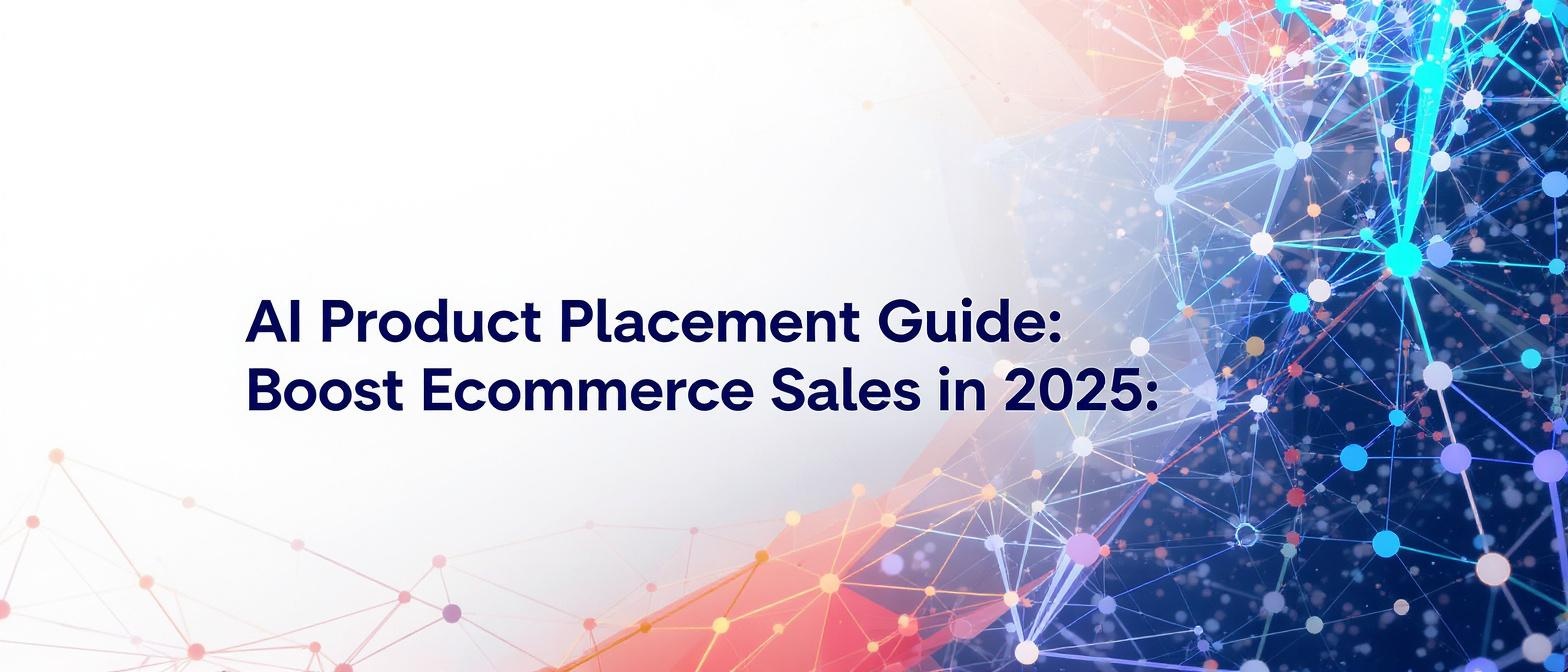The 2025 Ultimate Guide to AI Product Placement: A Data-Driven Framework for Boosting Ecommerce Sales
Estimated reading time: 12 minutes
Key Takeaways
- AI-driven ads move from disruption to seamless integration.
- Personalized product placements can increase brand recall and conversion rates.
- Robust analytics make measuring ROI more precise than ever.
- Scalable localization accelerates global expansion and market penetration.
- Adherence to ethical standards is vital for maintaining consumer trust.
In the sprawling, saturated landscape of digital media, the average consumer is bombarded with thousands of ads daily. This relentless firehose of content has bred a new kind of immunity; traditional banner ads are ignored, and pre-roll video ads are skipped with reflexive speed. For ecommerce brands, the challenge is no longer just about being seen—it’s about being integrated. The old playbook of expensive, static, and unmeasurable product placement is fundamentally broken. But a new, powerful strategy is emerging from the intersection of artificial intelligence and video: AI product placement.
This revolutionary approach is transforming how brands connect with audiences, moving from disruptive advertising to seamless, contextual integration. It’s a marketing strategy that is not only more effective but also infinitely more scalable and measurable, directly impacting ecommerce sales. Forget one-size-fits-all placements in blockbuster movies. Imagine serving a unique, culturally relevant product to every single viewer of a viral video, tailored to their location, preferences, and even the time of day they’re watching. This is the new reality. This guide will provide a comprehensive, data-backed framework for understanding, implementing, and measuring the ROI of an AI product placement strategy to secure your brand’s competitive edge in 2025 and beyond.
The Seismic Shift: Why Traditional Product Placement is Failing in the Digital Age
For decades, product placement was a game of high stakes and vague returns. A brand would pay a substantial fee to have its product appear in a movie or TV show, hoping the association with a star or a hit series would translate into sales. The process was manual, the costs were astronomical, and the results were largely anecdotal.
This analog model is crumbling under the weight of digital-era expectations for several key reasons:
- Exorbitant Costs & Lack of Scalability: Securing a prime spot in a single piece of high-profile content can cost millions, making it inaccessible for most businesses. Furthermore, that placement is static—the same product is shown to every viewer, regardless of relevance.
- Zero Targeting Capabilities: A viewer in Tokyo sees the same American soda brand as a viewer in Texas. This lack of personalization is a massive missed opportunity in a world where consumers now expect tailored experiences. A 2025 forecast from Statista predicts that the market for marketing personalization will grow by over 20% as consumers increasingly reject generic messaging.
- Unmeasurable ROI: The most significant flaw of the old model is the inability to track direct impact. Did that 3-second shot of a laptop in a film actually lead to a purchase? It was nearly impossible to know, leaving marketers to rely on correlation rather than causation.
- Content Fragmentation: Audiences are no longer concentrated on a few broadcast channels. They are spread across thousands of platforms, from YouTube and TikTok to niche streaming services. Manually placing products across this fragmented ecosystem is a logistical nightmare.
The digital consumer demands more. They crave authenticity and relevance, and AI-driven strategies are uniquely positioned to deliver it.
What is AI Product Placement? A Deeper Dive Beyond the Buzzwords
At its core, AI product placement is the use of artificial intelligence to digitally and dynamically insert or replace products, logos, and branded assets into video content. Unlike the old method of physically placing a product on set before filming, this is done programmatically, either in post-production or, in more advanced applications, in real-time.
This is made possible by a convergence of powerful AI technologies:
- Computer Vision: This acts as the "eyes" of the AI. It scans every frame of a video to identify optimal placement opportunities. It understands context, recognizing surfaces like tables, walls, or even clothing. It analyzes lighting, perspective, and camera motion to ensure any digitally inserted object looks completely natural.
- Natural Language Processing (NLP): NLP acts as the "ears" of the AI. It analyzes the video's dialogue, subtitles, and audio cues to understand the conversation's context and sentiment. This prevents awkward placements, like a celebratory beer brand appearing during a somber scene.
- Generative AI & 3D Rendering: Once a spot is identified, generative AI creates or modifies a 3D model of the product, rendering it seamlessly into the scene. It matches the video's lighting, shadows, and color grading with incredible precision, making the placement indistinguishable from reality. Discover 5 AI Video Enhancement Techniques to Revolutionize Video Quality Improvement in 2025 enables marketers to dynamically insert brands into video streams, tailoring the experience to individual user profiles without manual intervention.
This technological fusion allows for a level of precision and scale that was previously science fiction. To achieve this, platforms like Studio by TrueFan AI enable marketers to dynamically insert brands into video streams, tailoring the experience to individual user profiles without manual intervention.
The Data-Backed Revolution: 5 Tangible Benefits of AI Placement in 2025
The shift to AI product placement isn't just about technological novelty; it's about delivering superior, measurable business results. Here are five data-supported benefits that early adopters are leveraging for a significant competitive advantage.
1. Hyper-Personalization at Scale
The holy grail of marketing is delivering the right message to the right person at the right time. AI makes this possible on an unprecedented scale. Instead of one static product, AI can create infinite variations. A fitness influencer's video could show a viewer in a cold climate a thermal jacket, while a viewer in a tropical region sees a moisture-wicking tank top from the same brand. A 2025 report from McKinsey indicates that companies excelling at personalization generate 40% more revenue from those activities than average players. How to Scale Account-Based Marketing Personalization with AI Video Content is the engine that will power this next wave of personalization in video.
2. Unprecedented Global Reach
For brands aiming to expand internationally, localization is a major hurdle. It involves reshooting ads, redesigning packaging, and navigating complex cultural nuances. AI product placement obliterates these barriers. A single global campaign can be created, and the AI will handle the rest, swapping out products, labels, and even background elements to match local tastes and languages. Studio by TrueFan AI's 175+ language support and AI avatars are a prime example, allowing a single video asset to be localized for dozens of markets instantly.
3. Dramatically Improved Brand Recall & Engagement
Because AI-placed products appear as a natural part of the story rather than a jarring interruption, they are perceived more favorably by viewers. This non-disruptive approach leads to significantly higher brand recall and engagement. A landmark study by Nielsen found that in-content product placement can increase brand awareness by over 85%. When that placement is contextually relevant, the impact is even more profound, fostering a subconscious, positive association with the brand.
4. Enhanced Conversion Rates & Shoppable Experiences
The next evolution is already here: interactive, shoppable placements. AI can overlay a clickable, non-intrusive element on a placed product, allowing viewers to learn more or even purchase it directly from within the video player. This collapses the marketing funnel, reducing friction and converting interest into action at the moment of peak engagement. According to forecasts from Forrester Research, the shoppable video market is expected to become a cornerstone of ecommerce strategy by 2025, with AI being the key enabling technology. AI Marketing Videos 2025: Guide for Measurable ROI further explores how these enhanced features drive significant returns on investment.
5. Massive Cost & Time Efficiencies
Consider the budget for a traditional commercial: location scouting, crew, actors, equipment, post-production. Now, compare that to digitally inserting a product into hundreds of existing, high-performing videos. The cost savings are monumental. AI automates what was once a labor-intensive process, freeing up marketing budgets and allowing teams to focus on strategy and creative execution rather than logistical coordination. Create Professional A-Roll Footage in Minutes with AI Video Generator Technology exemplifies how AI-driven solutions can drastically reduce production timelines and costs.
Measuring the Unmeasurable: A Framework for Proving AI Product Placement ROI
One of the most compelling advantages of AI product placement is its measurability. The ambiguity of traditional placement is replaced by a dashboard of concrete data and KPIs.
Key Metrics to Track:
-
Direct Metrics:
- Click-Through Rate (CTR): For shoppable placements, this is the most direct measure of engagement.
- Conversion Rate: How many clicks led to an actual purchase? This directly ties the placement to revenue.
- View-to-Purchase Time: How long after seeing the product did the user convert? This helps optimize placement timing.
- Cost Per Acquisition (CPA): By tracking conversions, you can calculate a precise CPA for your placement campaigns.
-
Indirect & Brand-Building Metrics:
- Brand Lift Studies: Surveying control groups (who didn't see the placement) versus exposed groups to measure lifts in brand awareness, favorability, and purchase intent.
- Sentiment Analysis: Using AI tools to monitor social media and web chatter to see if the sentiment around your brand changes post-campaign.
- A/B Testing Results: AI allows you to test everything. Does a red coffee cup perform better than a blue one? Does placement in a morning scene convert better than an evening one? The data will provide the answers.
A 2025 report from the Interactive Advertising Bureau (IAB) highlights that nearly 30% of businesses are projected to use AI-driven analytics to enhance ROI measurement. Solutions like Studio by TrueFan AI demonstrate ROI through built-in analytics that track engagement per video variant and integrations with marketing automation pipelines, making it easier than ever to prove the value of your campaigns to stakeholders. AI Video Generation ROI: Marketing Intelligence Guide provides a deeper dive into effective ROI measurement strategies.
Your Step-by-Step Blueprint: Implementing an AI Product Placement Strategy
Transitioning to an AI-driven approach requires a strategic, methodical process. Here is a six-step blueprint for launching your first campaign.
Step 1: Define Your Goals & KPIs
What do you want to achieve? Is the primary goal to drive immediate sales for a specific product, or is it to increase overall brand awareness in a new market? Your goal will determine your entire strategy, from the content you choose to the metrics you track.
Step 2: Identify and Segment Your Audience
Leverage your first-party data (from your CRM, website analytics, etc.) to build detailed profiles of your target audience segments. Understand their demographics, psychographics, viewing habits, and content preferences. This data will fuel the AI's personalization engine.
Step 3: Select High-Resonance Content
Where will you place your products? You can choose from several options:
- Licensed Content: Partner with streaming services or media houses to place products in their existing library of shows and movies.
- Influencer Content: Collaborate with creators on platforms like YouTube or Instagram to digitally add your products to their videos.
- Owned Content: Enhance your brand’s own video content with dynamic placements to personalize it for different audience segments.
Step 4: Build Your AI Product Placement Tech Stack
Choosing the right technology partner is critical. When evaluating platforms, consider the following criteria:
- Ethical Approach: Does the platform use licensed, consenting individuals for its avatars, or does it rely on unauthorized deepfakes? A consent-first model is crucial for brand safety.
- Scalability & Speed: How quickly can placements be rendered? Can the platform handle campaigns across thousands of videos simultaneously?
- Realism & Quality: Scrutinize the quality of the digital insertions. Do they look natural and seamless?
- Language & Localization Support: If you have global ambitions, ensure the platform can support a wide range of languages and cultural adaptations.
- Analytics & Reporting: The platform must provide a robust dashboard for tracking the KPIs you defined in Step 1.
Step 5: Create & A/B Test Your Placements
Start with a pilot campaign. Develop several hypotheses you want to test. For example, you might test different product variations, various positions within the frame, or placements in different types of content (e.g., comedy vs. drama). Let the AI run these tests and gather performance data.
Step 6: Analyze, Optimize, and Scale
Use the insights from your pilot campaign to understand what works for your audience. Double down on the high-performing strategies and cut the ones that don't deliver. Once you have a proven model, you can confidently scale your AI product placement efforts across more content and larger budgets.
Navigating the New Frontier: Ethical Considerations & Future Trends
The Ethical Imperative
With great power comes great responsibility. As AI product placement becomes more widespread, navigating the ethical landscape is paramount for maintaining consumer trust.
Transparency is key. While placements should feel natural, brands should not be deceptive. Subtle, standardized disclosures (like a small, on-screen icon) can inform viewers that the content includes dynamic advertising without disrupting the experience. Furthermore, respecting data privacy laws like GDPR and CCPA is non-negotiable. The most reputable platforms prioritize a consent-first model, ensuring all parties—from the content creator to the talent represented in AI avatars—have given explicit permission. For more on this, publications like Forbes regularly cover the evolving standards of AI ethics in advertising.
Future Outlook - What's Next?
The technology is advancing at an exponential rate. Here’s a glimpse of what’s on the horizon:
- Generative AI Scene Creation: AI won't just insert products; it will generate entire background scenes around them, creating bespoke environments for brands within existing videos.
- Integration with AR/VR: As we move towards the metaverse, AI will place dynamic, interactive products within immersive augmented and virtual reality experiences.
- Emotion and Sentiment Analysis: Future AIs will be able to analyze a viewer's real-time emotional response (through facial cues via webcams, with consent) to time a product placement at the moment of peak positive sentiment.
- Hyper-Realistic Avatars: The line between real and AI-generated influencers will continue to blur, offering brands perfectly customizable, brand-safe ambassadors. Esteemed sources like WIRED often explore these cutting-edge developments in advertising technology.
Frequently Asked Questions
1. How much does AI product placement cost compared to traditional methods?
While enterprise-level costs vary, AI product placement is significantly more cost-effective. Instead of a massive one-time fee for a single placement, brands typically pay based on a SaaS model or a CPM (cost per thousand impressions) basis. This allows for more flexible, scalable, and budget-friendly campaigns with a clearer ROI.
2. What kind of content works best for AI product placement?
Any video content with clear surfaces and good lighting is a candidate. It's particularly effective in influencer vlogs, "how-to" videos, scripted web series, and streaming content where the environment is a natural fit for product integration. The key is contextual relevance—placing kitchenware in a cooking video is a natural fit.
3. How do you ensure the AI placement looks natural and not fake?
Leading AI platforms use sophisticated algorithms that analyze perspective, lighting, shadows, and motion blur in the source video. They then render the 3D model of the product to perfectly match these conditions, making it virtually impossible to distinguish from an object that was physically on set.
4. Can AI product placement work for B2B marketing, or is it just for B2C?
While B2C applications are more obvious, it's a powerful tool for B2B as well. Imagine placing your company's software on a laptop screen in a popular business podcast video, or inserting your manufacturing equipment into a documentary about factory automation. It's all about finding the right context to reach business decision-makers.
5. What are the first steps for a small business to get started with this technology?
The best first step is to start small and test. Identify your single highest-performing video asset. Then, partner with a self-service platform to create a few dynamic placement variations for that video. Many platforms offer starter tiers that are accessible for small businesses. For instance, testing how different audiences respond to your product within an influencer's review video can provide invaluable data. Create Professional A-Roll Footage in Minutes with AI Video Generator Technology enables businesses to start with a single video and a clear goal, measure the results, and scale based on proven success rather than committing a large upfront budget.
The Future is Integrated
AI product placement is not a distant, futuristic concept; it is a present-day reality that is fundamentally reshaping the advertising landscape. It represents a paradigm shift from interruption to integration, from speculation to data-driven certainty. For ecommerce brands, it offers a clear path to cutting through the noise, personalizing customer experiences at scale, and drawing a direct line between marketing efforts and sales.
The brands that will win the next decade of digital commerce will be those that embrace this technology, not as a gimmick, but as a core component of their marketing strategy. The time to audit your current approach and explore the power of intelligent, dynamic, and respectful product placement is now.




